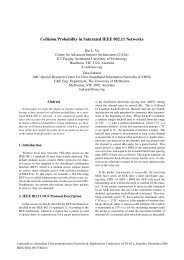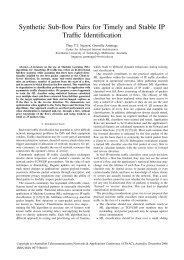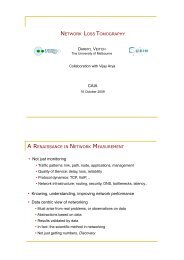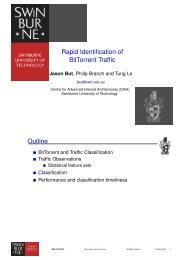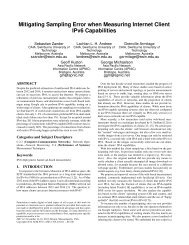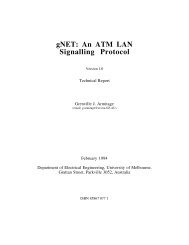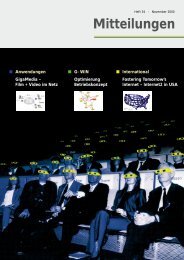Chapter 3 Time-to-live Covert Channels - CAIA
Chapter 3 Time-to-live Covert Channels - CAIA
Chapter 3 Time-to-live Covert Channels - CAIA
Create successful ePaper yourself
Turn your PDF publications into a flip-book with our unique Google optimized e-Paper software.
CHAPTER 3. TIME-TO-LIVE COVERT CHANNELS<br />
Table 3.5: Average transmission rates in (kilo) bits/second<br />
Dataset Direct MEI MEI0 MED MED0 DUB AMI<br />
<strong>CAIA</strong> 71(.99) 71(.99) 65(.99) 71(.99) 65(.99) 64(.98) 65(.99)<br />
Grangenet 68(.99) 68(.99) 59(.94) 68(.99) 59(.94) 61(.98) 62(.99)<br />
Twente 482(.97) 483(.99) 438(.98) 483(.99) 438(.98) 444(.99) 445(.99)<br />
Waika<strong>to</strong> 1397(.92) 1399(.97) 1096(.89) 1423(.99) 1102(.89) 1200(.97) 1204(.98)<br />
Bell 220(.89) 219(.91) 204(.89) 229(.95) 213(.94) 210(.92) 207(.91)<br />
Leipzig 11.6k(.96) 10.7k(.97) 10.2k(.92) 11.7k(.97) 10.2k(.92) 10.6k(.96) 10.5k(.95)<br />
The transmission rates depend on the capacity in bits per overt packet and the average<br />
packet rates (Equation 3.14). Table 3.5 shows the average transmission rates in bits per<br />
second for all modulation schemes and traces assuming ∆ = 1, no packet loss/reordering<br />
and hop count differences are used for MED, MED0 and AMI schemes 5 . The numbers in<br />
parenthesis denote the capacity in bits per overt packet.<br />
Overall the transmission rates depend on the available overt traffic, varying from tens<br />
of bits per second (<strong>CAIA</strong>, Grangenet), over hundreds of bits per second (Bell, Twente),<br />
<strong>to</strong> up <strong>to</strong> several kilobit per second (Leipzig, Waika<strong>to</strong>). Besides being standards-compliant<br />
and stealthier our novel schemes (MED, AMI) also have equal or higher transmission<br />
rates than the previous schemes (MEI, DUB). Overall we rank the new schemes as follows<br />
(from best <strong>to</strong> worst): MED, DED, AMI, MED0.<br />
With increasing packet loss and reordering rate the channel capacity reduces quickly.<br />
Figure 3.15 shows a con<strong>to</strong>ur plot of the capacity depending on the loss and reordering<br />
rate if packet loss can be detected (Equation 4.10). Figure 3.16 shows the capacity when<br />
packet loss cannot be detected (Equation 4.9). In both figures pN is the average error rate<br />
for MED with A = 1. For reordering we set b = 1, d = 1, and r = 1/rate − 2 (see Section<br />
3.3), where rate is the reordering rate shown on the x-axis.<br />
3.5.4 Burstiness of errors<br />
The burstiness of errors does not affect the channel capacity, but it affects the performance<br />
of techniques for reliable data transport. On the TTL channel bit errors often occur in<br />
bursts. How bursty the errors are depends on the trace and the modulation scheme.<br />
We illustrate this using results for the MED and AMI modulation schemes and the<br />
<strong>CAIA</strong> and Leipzig traces. Figure 3.17 shows CDFs of the distance between errors in bits<br />
for the measured errors and simulated uniformly distributed errors with the same probabil-<br />
ities. The empirical error distributions are clearly burstier than the uniform distributions.<br />
5 The transmission rates can be increased by encoding multiple bits per packet or packet pair. However,<br />
as explained earlier this would likely reveal the covert channel.<br />
62



